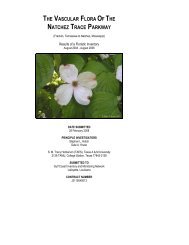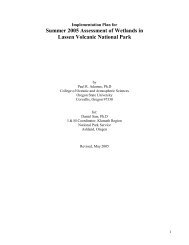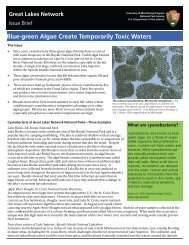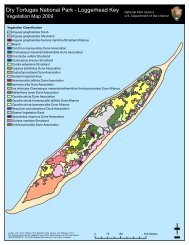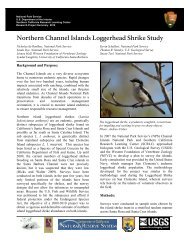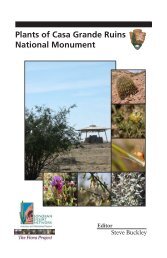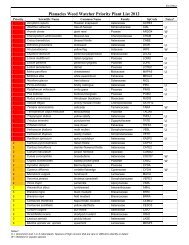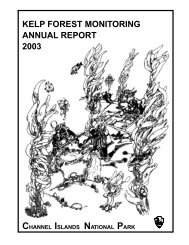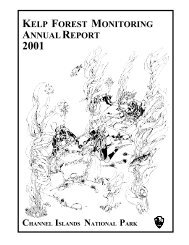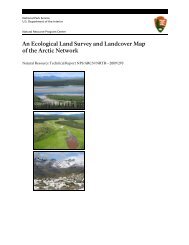Complexity of Caribou Population Dynamics in a Changing Climate
Complexity of Caribou Population Dynamics in a Changing Climate
Complexity of Caribou Population Dynamics in a Changing Climate
You also want an ePaper? Increase the reach of your titles
YUMPU automatically turns print PDFs into web optimized ePapers that Google loves.
28<br />
<strong>Complexity</strong> <strong>of</strong> <strong>Caribou</strong> <strong>Population</strong> <strong>Dynamics</strong> <strong>in</strong> a Chang<strong>in</strong>g <strong>Climate</strong><br />
Figure 3. Western Arctic Herd caribou <strong>in</strong> Kobuk Valley<br />
National Park. Warmer temperatures <strong>in</strong> w<strong>in</strong>ter and spr<strong>in</strong>g<br />
could lead to more dangerous cross<strong>in</strong>gs <strong>of</strong> rivers and lakes<br />
that have been frozen solid <strong>in</strong> previous years.<br />
nents. Quantity and quality <strong>of</strong> forage species are governed<br />
by the rate <strong>of</strong> summer growth, whereas <strong>in</strong> w<strong>in</strong>ter, snow<br />
depth and density conditions alter availability <strong>of</strong> forage.<br />
Variables <strong>in</strong> summer weather <strong>in</strong>fluence the <strong>in</strong>tensity<br />
and duration <strong>of</strong> <strong>in</strong>sect harassment. Fall is the period<br />
when caribou must replenish their energy and prote<strong>in</strong><br />
reserves before fac<strong>in</strong>g the long w<strong>in</strong>ter when prote<strong>in</strong>rich<br />
forage is limited. Fall body condition is a strong<br />
determ<strong>in</strong>ant <strong>of</strong> pregnancy rates (Cameron et al. 1993).<br />
Climatic conditions also strongly affect the distribution<br />
and abundance <strong>of</strong> parasites, <strong>in</strong>sects and diseases that<br />
exert vary<strong>in</strong>g levels <strong>of</strong> <strong>in</strong>fluence on caribou population<br />
dynamics. The importance <strong>of</strong> these <strong>in</strong>fluences decl<strong>in</strong>e<br />
with latitude. Increased movements, due to <strong>in</strong>sect<br />
harassment, have been l<strong>in</strong>ked to reduced growth <strong>of</strong><br />
caribou calves over summer (Couturier et al. 2009). A suite<br />
<strong>of</strong> diseases and parasites can negatively affect caribou<br />
body condition, <strong>in</strong>fluenc<strong>in</strong>g their ability to survive<br />
and reproduce, cause mortality or loss <strong>of</strong> the fetus.<br />
<strong>Climate</strong> change is expected to modify current patterns<br />
<strong>of</strong> snow, ic<strong>in</strong>g, ra<strong>in</strong>, temperature, w<strong>in</strong>d, clouds, and<br />
seasonality with<strong>in</strong> the range <strong>of</strong> caribou. Temperatures<br />
NPS photograph by K. Joly<br />
Figure 4. A summer wildfire where caribou overw<strong>in</strong>ter. Warmer, drier conditions <strong>in</strong> the future could lead to more wildfire <strong>in</strong><br />
both boreal forest and tundra ecosystems. Lichens, an important w<strong>in</strong>ter forage for many caribou herds, can take many decades<br />
to recover to previous levels follow<strong>in</strong>g burn<strong>in</strong>g.<br />
are predicted to <strong>in</strong>crease under all climate change<br />
scenarios, rais<strong>in</strong>g a suite <strong>of</strong> problems for caribou. Warm<strong>in</strong>g<br />
<strong>in</strong>creases summer forage quantity but can reduce its<br />
quality (Callaghan et al. 2004), while quantity <strong>of</strong> lichens<br />
is reduced (Joly et al. 2009). Conversely, caribou will<br />
presumably benefit from shorter w<strong>in</strong>ters, with lower<br />
energy costs for w<strong>in</strong>ter activities and body ma<strong>in</strong>tenance.<br />
Warmer w<strong>in</strong>ters may allow for greater <strong>in</strong>-season snow<br />
melt, which also may be beneficial for caribou (Tyler et<br />
al. 2008). Dryer conditions <strong>in</strong> summer are expected to<br />
result <strong>in</strong> <strong>in</strong>creased prevalence <strong>of</strong> wildfire (Duffy et al.<br />
2005). <strong>Caribou</strong> are known to avoid burned w<strong>in</strong>ter habitat<br />
for decades, both <strong>in</strong> the tundra and boreal forest, (Joly et<br />
al. 2007) likely due to the destruction <strong>of</strong> forage lichens,<br />
which can take up to a century or more to recover.<br />
Thus, fire can <strong>in</strong>fluence the nutrition and movements<br />
NPS photograph by K. Joly




